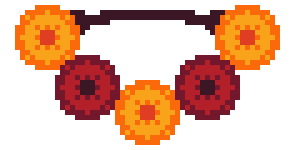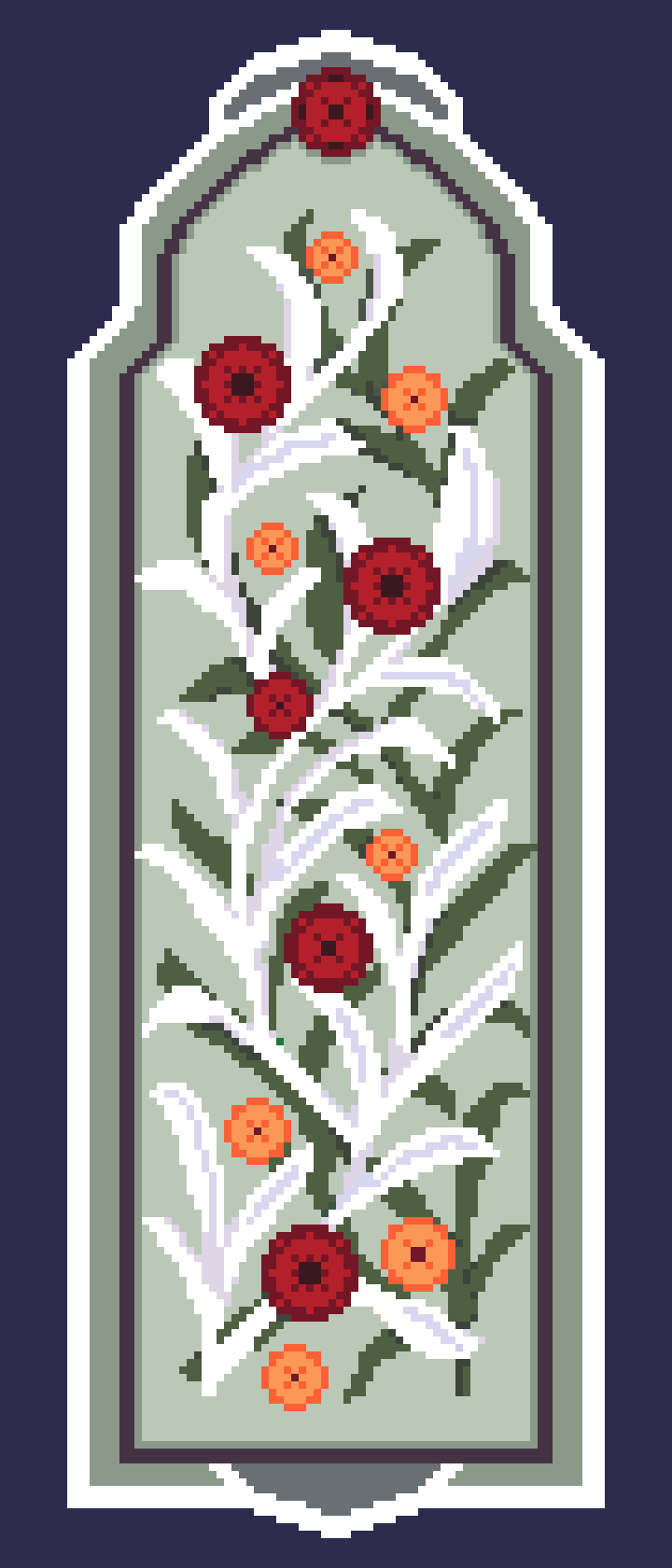Gesel Ovaghe
Gesel Ovaghe, or Holy Week, is the Asfye celebration of the summer solstice. It is the Highest festival of the year, in the Asfye Religious Calander, the Ñazíl Ñíñíñíma Koshévkhán and is their new year.
History & Theology
"Come! Rejoice as the nations under the sun. Praise abundance and indulge in your blessings on the highest day."
Pre-Asfye
Writing and the Őlóv Daghlóv belong hand-in-hand. There was a pre-Asfye, pre-Őlóv Daghlóv summer solstice festival, so the archaeologists say. Before the invention of writing, the oral tradition maintained the solstice festival. Oral traditions are fickle, so the Asfye lost the ins and outs of this tradition. It was most likely a celebration of a fertility or nature goddess. That certainly explains some modern traditions, like shaving young men's beards or the Nósakhé crown.The Ofe Kana
The mythological origin of the Gesel Ovaghe comes from King Éfonvos, considered one of the greatest Asfye Kings, or at least a good parable about lust. Before his battle against Shémzír, Éfonvos gave a feast to God – thanking God for his blessings and cleansing himself before he went to war. While this feast was not explicitly on the solstice, it is the basis for the Gesel Ovaghe; thanking God for his blessings and purity. With the years, the theology surrounding thankfulness, protection and abundance has solidified into the Gesel Ovaghe. Religious scholars will cite verses from just about anywhere – Gakóghe Sho, the Bísagzsafoghe Shafye – to do with feast making and merriment, even if many of these verses are elsewhere claimed to be about day-to-day worship. Nonetheless, a single feast of many in the Ofe Kana has grown into the modern Gesel Ovaghe. The core justification for scholars, even if the festival isn’t in Ofe Kana, is simple: as Asfye, they believe God, in the mortal world, is the sun. The longest day coincides with his greatest, where he can protect and bless the Asfye people for the longest time. Therefore, considering the perhaps hundreds of blessings given to the Asfye by their God, shouldn’t they celebrate and be thankful on that day?History
Now-Gevushra Énos Pezhén wrote he first detailed account of Holy Week traditions in 1295. His account mainly focuses on feasting, religious law and the study of Ñaza Ofe Kána. However, he does also mention dancing and the blazing wheel – noting them as "folk and saghes" traditions. His text, and the culture of intense religious scholarship fostered by the Asfye, have led to the minutiae of Holy Week celebrations being picked dry by Clerics and scholars alike. The religious debate around holidays even forms its own discipline – Daghóz-sezaz! In 2347, by Emperor Ragzan XI Úzokha decreed the Gesel Ovaghe as the start of the Asfye new year, due to its place as the highest Asfye festival. Because of this, many competitive schools like the Bonmél Dóshíl Tozhín and the University at Bisafdjra will select their students soon after Holy Week to join their hallowed halls.Peace
”A man with a blade in his hand is certain to descerate God’s land”Blood is saghes, unclean, according to Asfye Purity Law. Blades are prohibited during the the Holy Week – including kitchen knives and razors – and no unkind actions should be performed. The blade ban is followed near-universally but people are not exactly prone to throw grudges or cruelty away for a week. Historically, during times of war, soldiers and warriors have been exempt from the blade prohibition. Eunuchs and women also do not need to follow the rule either, according to many scholars. This avoids one of the great questions – considering the Gesel Ovaghe is a festival of feasting and plenty, how would they make the feast when there are no knives? Until recently, Asfye religious law was written only using male terms, rather than "tafa nos ñe". So, women (and eunuchs) apparently can use blades. Cooking is already a near all-female job, regardless of the time of the year. During Holy Week, the community’s women will prepare meals together to feed their families, and save on costs of items such as meat and spices. For the common woman, the preparation of the solstice feast often feels somewhat sacred. To not have to pay a whole new cooking staff, most kitchens of the well-to-do are near entirely female affairs besides maybe a butcher. The environment of a kitchen is very different from the ramshackle of the community’s women – there is certainly less gossip and liveliness to the matter.
What counts as a blade?
“Blades”, you may be thinking, is a vague category. That can be anything from a razor to swords. Obviously, swords are saghes during Holy Week. But what materials make a blade? How sharp must it be? The clerics and scholars could make a career simply out of arguing about what counts of a blades. In the simplest sense, a blade is defined as sharpened metal or bone. Razor blades are outlawed during the Holy Week, and so are most cooking knives, at least for men. Butchers are often given grace for the week, waving the requirement – still following the regular purification rituals before entering the Gekhshína. For eating, knives are dulled “enough” not to count as true blades, although this is more for practicality's sake, or made from wood. Good luck with splinters.Grooming
Good grooming is a sign of good moral fibre, at least for the Asfye. Asfye wash their hands and feet regularly – before prayer and meals to prevent the meal or prayer from becoming saghes. After menstruating, women will bathe to purify themselves. During the Gesel Ovaghe, the Asfye take their cleanliness more seriously than ever. On Holy Week, the Asfye flock to bathhouses for purification and the feeling of a new beginning. In the Asfye countryside, bathing in the Lusheve, sometimes daily replaces the bathhouses. The use of perfumes and oils to further cleanse oneself is common. Furthermore, a second wash of hands is done before eating the solstice feast using the blessed Gesogho cup.New Clothes
For the first day of Holy Week, families exchange gifts. This symbolises God’s abundance and generosity. Most common of the gifts is new clothes – symbols of purity, cleanliness and new beginnings in reds, yellows and whites. These gifts are usually high quality and/or handmade to follow the Asfye Purity Law. Some communities will substitute new clothes with repairing other’s clothes due to the costs of fabric or a tailor. This is common for emigrant Asfye communities like that in Luze Immigrant's Quarter as they cannot ensure the following of Purity Laws.Headcoverings
Head-coverings and Asfye women have a complex history. According to the strictest interpretation of purity law, women should entirely cover their hair in full respect of God. This style of head covering is called the Kasezh. This style has not been in style for a good couple of centuries, only religious fanatics, The 100 Wives and some widows will wear it on the regular. Most women will never wear it, unless they go on pilgrimage to, say, Khegshin. Daily, a lot of Asfye will cover their heads for practical reasons in a variety of ways from bonnets to square scarves. Upper class women will mostly forgo head coverings, or wear headbands and hairnets. However, as one must cover their head in the Gekhshína, there is fashion in head coverings. Thin veils of lace or embroidered tulle with a Paste and biliments have become a la mode. But these thin veils are expensive and out of reach for the average Asfye woan, who will mostly wear hand-embroidered square scarves as ever. Men’s head coverings are a less controversial matter. Grown Asfye men will wear a Lévsev, a type of skullcap, while the sun is up. An Asfye man will often have many Lévseva of varying formality, the most complex having embroidered designs of many colours. In the north, near the Chershe foothills, these Lévseva often have a strip of fur at the bottom. During the gift giving, many Asfye men receive a new Lévsev as their gift. These Lesev on Holy Week are always white or yellow. Some men also will cover themselves in a white shawl during Prayer, in similar style to a very loose Kasezh.Nósakhé
One of holy week's enduring traditions is to make a wear a flower crown called a Nósakhé. This is a younger women's tradition, as the older women of a community are often cooking or wrangling children. The flowers used depend on region but commonly used flowers are lavenders, white lilies, marigolds, orange blossoms, buglosses, myrtle springs (for engaged women) and carnations. Each flower has a different meaning, made more complex depending on composition. However, the crown itself represents the blessings of God and the rich landscape of Gomakshzo The Nósakhé is worn while dancing the Gíshpí an up-tempo, partnered folk dance. Historically, Gíshpí was not a romantic dance, nowadays, Gíshpí is near universally performed by young, unmarried Asfye as a courtship method.Beards
Men cannot shave on Holy Week due to the prohibition of blades. Prior to Holy Week, men will partially shave, to maintain cleanliness, gese but will not fully shave due to the taboo of a cleanly-shaven face (unless you're a monk). This is in spite of the tradition of shaving newly adult men's beards on Holy Week. The young man, upon the growing of his first full beard will be shorn by his female relative in front their community. This welcomes them into adulthood.Adornment
Kús
Henna, known by the Asfye as Kús, is common during every Asfye celebration. This is no different during Holy Week. Women and girls, will wear Kúshézh, especially if they have no jewellery, as it is cheaper. An older family member will often create the Kúshézh for each family member, sometimes over a couple of days, before Holy Week. Upper class women also indulge in Kúshézh - hiring a Kúshézhésho to create her Kúshézh. Kúshézh is a practice barred to men as it ruled a type of women's dressing. Men should be barred from the room home while his female relatives create their Kúshézh. Thus, Kúshézhésho is a all female profession, and one of the rare female professions of status within the Asfye world. Designs vary in complexity. Length of the a Kúshézh pattern depends of age: palms only for young children, mid forearms for unmarried women, up to the elbow for married women. Most Kúshézh consists of Geometric designs, with messages often snuck into the design. Common motifs include flames, the sun, circles, candles and flowers. Kúshézh is attested in the Ñaza Ofe Kána. However, there is theological debate about its use. Is it a religious or folk tradition? Is truly gese. Ask Asfye women and they will tell you, they wear is a celebration of God's gifts.Jewellery
Jewellery is common during Holy Week. Bangles and bracelets of base metals are the most common, usually heirlooms. The very rich procure new golden jewellery as Holy Week gifts. Rubies are the most precious stone during Holy Week, often crafted into sun-shaped pendants. In the south, girl place bells in their hair while they dance to try bring God’s attention to their praise.Practices
Worship
"God hears prayer 1000 times louder on his longest day."







Fascinating celebration surrounding the summer solstice and their sun god. I really enjoyed reading about the symbolic purposes of many different aspects of the celebration, such as the prohibition on handling blades, the colors/flowers of the Nósakhé crown, and so much more. Awesome work! <3
Thank you Aster!
Hi, Crabetty! It's been a bit since WE, but life got away from me since the WA team told me they didn't receive a response... Regardless, I wanted to let you know that you won the Tradition prompt for the event! The reward included a WorldAnvil mug (design of winner's choice) and a Deck of Worlds. Is there a best way for us to chat so I could make that happen for you? :)